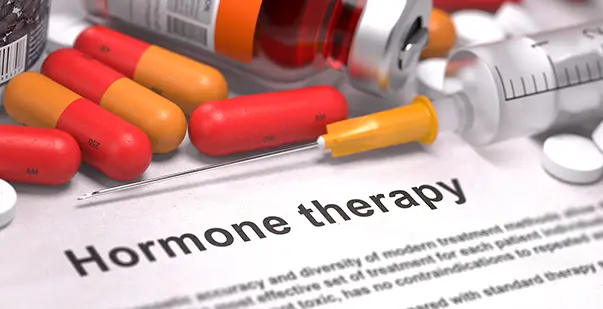Hormone replacement therapy (HRT) is used to treat symptoms and manage certain health problems by using hormones. HRT is usually safe but it can increase the chance of cardiac events like cardiac arrest.
HRT) may impact cardiac arrest by increasing the risk of blood clots and cardiovascular complications. Learning CPR is vital, as it equips individuals with life-saving skills during emergencies. It also teaches you how to provide critical assistance until medical professionals arrive. This improves the chances of survival for cardiac arrest victims.
Register with us today for online CPR training at the American HealthCare Academy and learn how to use CPR effectively. This will be beneficial in cases of cardiac arrest caused by hormone replacement therapy (HRT). Our thorough training will teach you the skills and information you need to respond with confidence and even save lives.
In this blog, we’ll talk about hormone therapy and cardiac arrest, and who might need it. We’ll also talk about the problems of hormone therapy that lead to cardiac arrest and the first-aid needed for it.
What Is Hormone Therapy And Who Needs It?
Hormone replacement therapy refers to the use of hormones like estrogen, progesterone, or testosterone to fix hormonal issues or imbalances in the body. Here are a few examples:
1. Symptoms of menopause: It is often given to people with menopause symptoms like hot flashes and soreness in the vaginal area. Research shows that hormone treatment can help women with the symptoms of menopause and make their lives better overall.
2. Certain cancers: HRT is used to treat diseases that are affected by hormones, like breast and prostate cancer. It aims to block or suppress the hormones that fuel cancer growth, helping to slow down or control the progression of the disease.
3. Osteoporosis: Doctors may use hormone replacement therapy (HRT) to treat osteoporosis. Postmenopausal women have several options to supplement their declining hormone levels, particularly estrogen. Estrogen helps slow down bone loss and reduces fracture risk. When making a decision about osteoporosis treatment, it is important to carefully consider the risks and benefits of using HRT.
Depending on the person’s needs, hormone replacement therapy can be given in the form of pills, patches, gels, creams, or shots. But since there’s a link between hormone treatment and cardiac arrest, it’s important to talk to a doctor to find out if you do need HRT.
Learning CPR is crucial for everyone, including those taking hormone replacement therapy (HRT). This is due to the fact that cardiac arrest can occur in anyone regardless of their medical history. Individuals who have CPR skills can effectively respond during emergencies. They can provide immediate assistance until medical help arrives. The American HealthCare Academy’s online CPR classes will teach you how to save lives during cardiac arrest. Enroll today to make a difference and save lives.
Complications Of Hormone Therapy Leading To Cardiac Arrest
It is important to know about the complications that can come up with hormone treatment and cardiac arrest. Here’s what you should know about hormone therapy’s side effects and first aid for cardiac arrest:
1. Increased Risk of Blood Clots: HRT, especially estrogen treatment, can increase the risk of blood clots. This can block blood flow and possibly cause cardiac events.
2. Cardiac arrest: HRT especially for women after menopause, can increase the risk of strokes leading to cardiac arrest.
3. Arrhythmias caused by hormone therapy: When HRT interferes with the usual electrical signals of the heart, it can cause arrhythmias, such as ventricular fibrillation or ventricular tachycardia. This can lead to cardiac arrest if they are not treated right away.
How To Administer First Aid to a Patient Taking Hormone Therapy?
- Recognize cardiac arrest quickly: Know the signs of cardiac arrest such as rapid loss of consciousness, not breathing or gasping strangely, and no pulse.
- Call for help in an emergency: Call 911 right away to make sure that professional help is on the way.
- Start CPR for cardiac arrest: Start doing chest compressions at a rate of 100–120 per minute to keep blood flowing to critical organs.
- Help the patient take rescue breaths: Combine chest compressions with rescue breaths by tilting the person’s head back, lifting their chin, and giving them two rescue breaths after every 30 chest compressions.
- Use an automated external defibrillator (AED): If you have access to one, use it to check the patient’s heartbeat and give a shock if needed. Attach the pads and carefully follow the directions given by the AED.
- Keep doing CPR: Keep doing chest compressions and rescue breaths in a cycle until professional medical help comes or the person shows signs of life.
Conclusion
Hormone treatment can be very helpful for people who are dealing with hormonal imbalances in their bodies. But it’s important to know about the possible side-effects that could occur, like cardiac arrest.
Knowing the signs of cardiac arrest and how to give first aid and CPR can save a person’s life. If you or someone you know is getting hormone treatment, you can learn CPR online with the American HealthCare Academy and be ready to save lives. Sign up now, and you can learn life-saving skills from the comfort of your own home.













